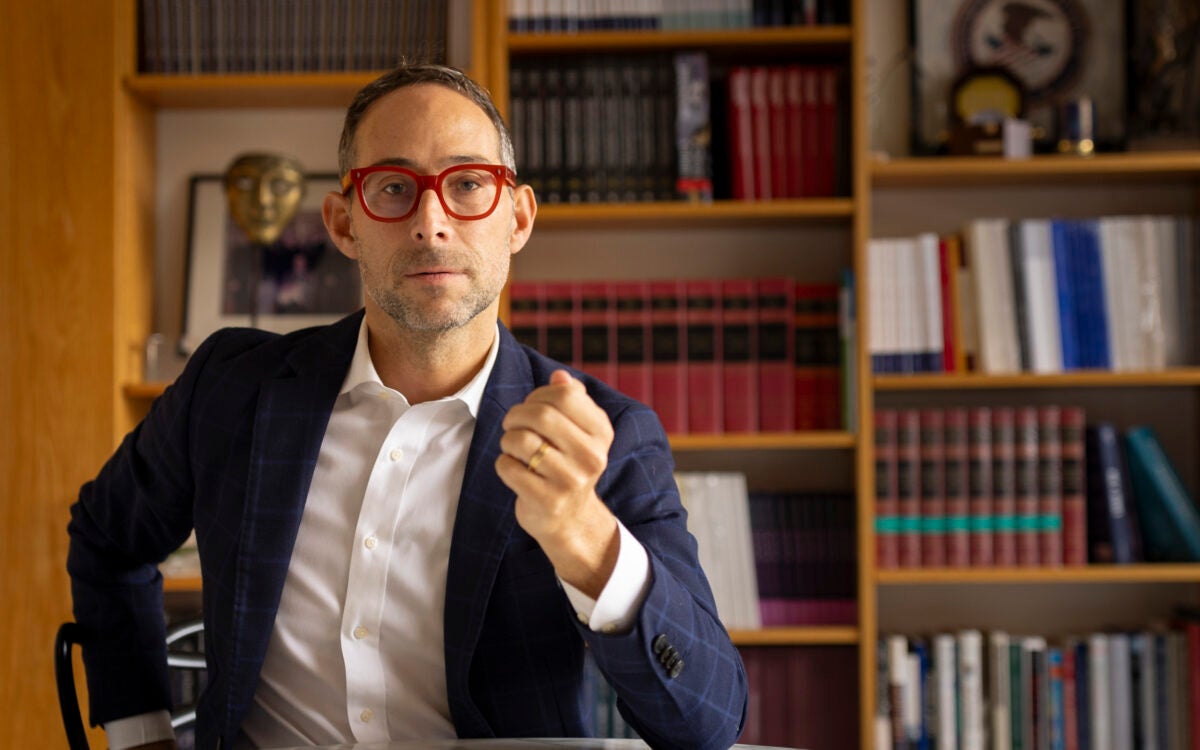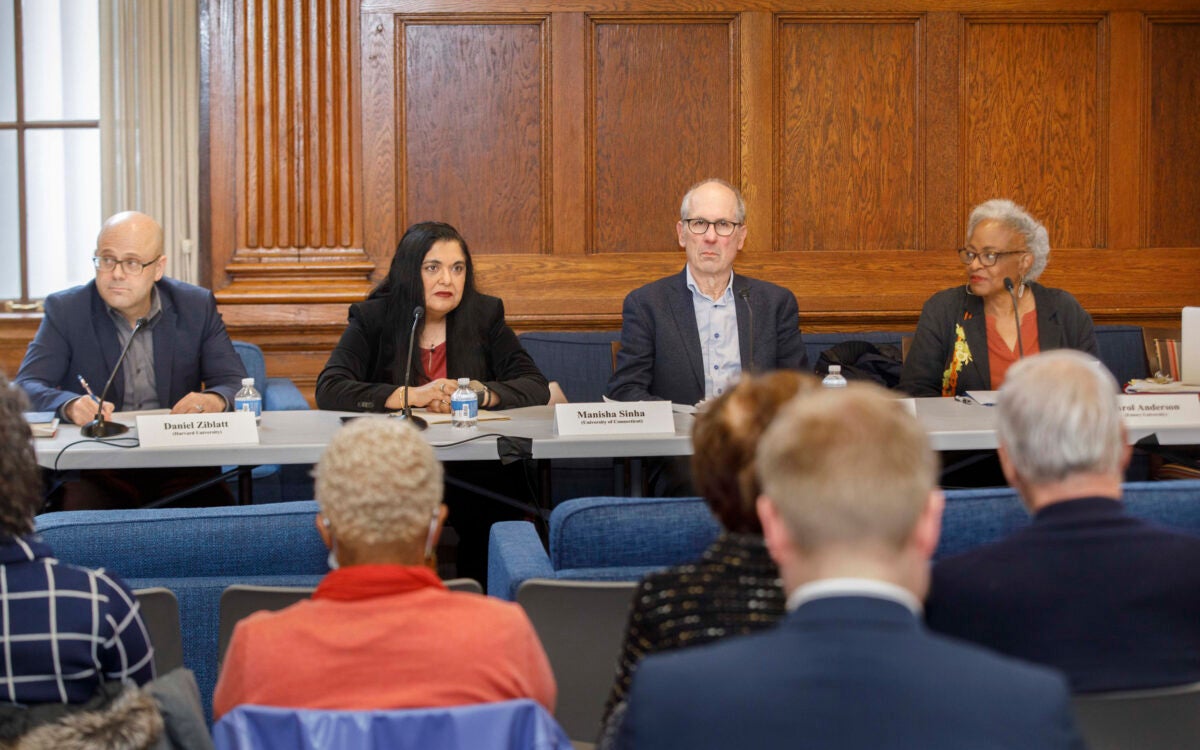Confronting tuberculosis
Drug-resistant strains of TB focus of Lesotho hospital
In the shadow of a hill where lepers once lived, a tuberculosis hospital designed for those infected with deadly, drug-resistant strains of the disease is giving hope to a new generation of medical pariahs in the tiny African nation of Lesotho.
Abandoned by much of the medical establishment – and in some cases cast out even by their own families – the patients at Botsabelo Hospital are receiving groundbreaking care that sets a new standard for treating multi-drug-resistant tuberculosis (MDR-TB) in the developing world.
The hospital, whose name means “Place of Refuge,” was opened last fall by the Boston-based nonprofit Partners In Health, which has close ties to Harvard Medical School, the Harvard School of Public Health, and Harvard-affiliated Brigham and Women’s Hospital. The facility, operated in collaboration with the Lesotho Ministry of Health and renovated with funding from the Open Society Institute, features sealed wards with negative air pressure designed to keep airborne tuberculosis bacteria from escaping. Pressure gauges over each door are checked twice daily, and an alarm warns staff of ventilation-system problems. Air leaves the building through enormous filters that noisily scrub the exhaust, ensuring it is safe. Admission is tightly controlled and staff and visitors wear masks to ensure their own health as they work with the sickest of Africa’s sick.
The patients at Botsabelo are truly in need of refuge. Many left Lesotho to work in South Africa’s mines and became infected with HIV, the virus that causes AIDS, and then TB. They sought medical care there, which failed, sometimes despite several courses of treatment. Thin and weary, wracked by infectious coughs, they made their way home to the tiny mountain kingdom. Others were infected closer to home, first with AIDS and then TB. Ultimately, they came to Botsabelo.
Once there, they found medicine to fight the HIV ravaging their bodies and doctors experienced in treating the most difficult tuberculosis strains. They found a program built not from the wreckage of the existing, barely functioning health care system, but designed anew based on modern medical knowledge and the latest technology. They found a well-stocked pharmacy, new thinking about facility design, and an army of community health workers who, through good, old-fashioned house calls, would ensure they maintained the difficult drug regimen employed against TB bacteria.
Even with that assistance, however, fighting multi-drug-resistant TB is a difficult battle, one they sometimes lose. Partners In Health co-founder Paul Farmer, the Maude and Lillian Presley Professor of Social Medicine at Harvard Medical School, told of consoling a physician working at Botsabelo who had recently lost two patients in the same day.
“This is a hardened warrior in the struggle against these diseases,” Farmer said. “A day like that, when you have the drugs and have the resources and you know how to treat the patients and they die anyway. A day like that, those are the low points. I told him that we’re coming at those two epidemics . tardily. They collided as we predicted 15 years ago and now we’re seeing patients who’ve been sick for a long time.”
The work of Farmer and other Harvard faculty members in Lesotho is an example of an enormous and diverse body of global health research, education, and training across Harvard. Harvard researchers toil away to understand everything from the genetic code of the malaria parasite to the impact of air quality on human health, instructors impart the latest in medical knowledge to top students, and colleagues at Harvard’s many affiliated institutions not only teach and conduct research of their own, they also put that knowledge into action to improve people’s lives – in Boston and around the globe.
Tuberculosis has spread worldwide in concert with the AIDS pandemic. The disease pounces on patients whose immune systems are destroyed by HIV, and together the ailments have become a pestilential one-two punch. AIDS has become so important in spreading TB that 80 percent of Lesotho tuberculosis cases occur in people infected with HIV. Tuberculosis, meanwhile, has become the No. 1 killer of African AIDS patients.
“It would be hard to think of a worse combination of afflictions to have,” Farmer said. “We’d be crazy to think that an airborne disease is simply going to disappear without some aggressive intervention, and that includes prevention. There’s a lot of work to do.”
Tuberculosis has become a widespread killer of those infected with HIV because it is widespread in the general population. Almost a third of the world’s population has been infected with TB bacteria, but healthy immune systems can keep it in check. A healthy person exposed to TB has only a one in 10 chance of developing tuberculosis in their lifetime, while those exposed to TB bacteria who are suffering the effects of HIV have a one in 10 chance of developing the disease in a single year.
TB drugs are divided into three categories representing first, second, and third lines of treatment. The first-line drugs are more effective and have fewer side effects than those on the second line. Third-line drugs are of questionable effectiveness or have other hurdles to their use, such as high prices. Poor adherence to TB treatment programs has led to the rise of strains resistant to one or more of the drugs; these strains are called “multi-drug-resistant.” Most worrisome has been the emergence of strains dubbed “extensively drug-resistant (XDR),” which are immune to the two most important first-line and several second-line drugs.
In October 2006, Yale University researchers reported an outbreak of XDR tuberculosis among South African AIDS patients in KwaZulu-Natal, just across the border from Lesotho, that killed 52 of 53 it infected – a 98 percent mortality rate. Further, the average survival time after diagnosis was just 16 days, compared with six years or longer for other multi-drug -resistant strains.
“That’s just hours in the TB world. We were terrified when we heard it,” said Partners In Health’s Lesotho Country Director Jennifer Furin, an instructor in medicine at Harvard Medical School and infectious disease specialist at Harvard-affiliated Brigham and Women’s Hospital.
With a significant portion of southern Africa’s adult population infected with AIDS and susceptible to TB, the killer XDR-TB outbreak set alarm bells ringing throughout the international health community.
“It’s just the most incredibly frightening story you’ve ever heard,” said Partners In Health co-founder Jim Yong Kim, the Francois-Xavier Bagnoud Professor of Health and Human Rights at the Harvard School of Public Health and professor of social medicine at Harvard Medical School. “If we don’t get on top of this one, we’re going to see terrible, terrible outcomes.”
Efforts to head off the disease are hampered by the fact that much of the developing world lacks the specialized facilities needed to handle TB. Instead, tuberculosis patients are often kept in the same wards as those with other ailments or, if they are separated, there are no measures to contain the airborne bacteria. The result is that hospitals filled with AIDS and TB patients, lacking the precautions found at Botsabelo, can become a source of new infections rather than of cures.
“They go into the general hospital with everyone else. With no infection control and with HIV in the rest of the population, others will get it,” Kim said. “So this has to happen in every country. [ Botsabelo Hospital ] is a metaphor for what the 21st century has to look like.”
Kim has ample experience on which to draw in assessing Botsabelo. In the mid-1990s, he led Partners In Health’s efforts to treat multi-drug-resistant tuberculosis in urban Peru, a project that showed international health officials that MDR-TB could be treated in poor countries. He then spent three years as head of the World Health Organization’s HIV/AIDS division before returning to Harvard in 2006.
Though the Peruvian experience has been helpful, Kim said Peruvian tuberculosis patients were not co-infected with HIV. That complication makes the Lesotho situation – and that in surrounding nations – far graver.
“If we get a 50 percent cure rate, we’ll be doing well,” he said. “In Peru, people were not cross-infected with HIV, and we got an 80 percent cure rate.”
Kim, who toured the Botsabelo facility in February for the first time since it opened, expressed admiration for the work there. By showing the world that modern, high-level care can be provided in a nation as poor as Lesotho, he said, Botsabelo’s staff is simultaneously silencing critics and paving the way for similar facilities elsewhere.
Before April 2007, Botsabelo was run by the Lesotho Ministry of Health as a leprosy hospital. When Partners In Health reached an agreement with the ministry in 2006 to bring testing and treatment for HIV to 10 existing health clinics in Lesotho’s mountains, they made improving diagnosis and treatment of TB a top priority, along with women’s health and detection and treatment of sexually transmitted diseases. As evidence mounted that southern Africa faced a lethal combination of HIV and drug-resistant TB, Partners In Health obtained support from the Open Society Institute and embarked on a program to help the nation control multi-drug-resistant tuberculosis.
Country Director Furin said the group first convinced the government that leprosy, a treatable bacterial disease, didn’t require an isolated facility, and then began renovating Botsabelo to handle drug-resistant tuberculosis.
The hospital has room for 20 patients, including separate wards for men and women and three isolation wards. Patients typically stay for several weeks or months, until they become noninfectious. After that, they transition back to the community, though treatment must continue for up to two years before the disease is cured. During that extended stay in the community, patients get regular visits by Partners In Health’s tuberculosis-treatment-support workers.
For some patients an intermediate step is needed, either because their illness isn’t yet stable or because of social issues at home; Partners In Health rents homes near the hospital where these patients can live and still get support.
“This is essentially like an extension of the hospital. They live in areas so remote [it is needed],” said Instructor in Medicine K.J. Seung, a tuberculosis specialist at Botsabelo.
Whether the patients are in transitional housing or receiving visits from health workers at home, support is crucial in ensuring the complex drug regimen is followed. Partners In Health’s MDR-TB community coordinator, Likhapha Ntlamelle, said the organization has about 80 patients that it visits twice daily. Those patients, she said, typically take 15 pills each morning to fight their TB, plus a daily injection, plus another five pills to fight HIV, plus more drugs – possibly another five or 10 – to fight side effects of the primary medications.
“It’s really not very easy for these patients to take this treatment, especially because of the side effects,” Ntlamelle said.
Botsabelo Hospital Director Hind Satti, whom Kim described as one of a handful of people with expertise treating multi-drug-resistant TB and HIV in the developing world, gets much of the credit for the facility’s success, Furin said. She also praised Salmaan Keshavjee, an assistant professor at Harvard Medical School, for help negotiating with the Lesotho government.
As Satti walked a group of visitors through the hospital in February, she described the patients’ backgrounds, reciting a litany of hardships: lost jobs, fearful families, and an ailment that just won’t go away. While the focus of treatment is often on a patient’s physical well-being, Satti said it is also critical to look after patients’ emotional welfare. That is why the hospital’s support program reaches out to tuberculosis patients’ family members and communities, preparing them to take the patient back.
“A very important issue is patient social support,” Satti said. “Patients are very sick; they’ve lost their jobs and have children to take care of. Supporting their families will allow them to take their medication and not default.”
Though by early 2008, the hospital had only been operating for a few months, it had so far been effective. Of the 94 patients that had come through the facility by February, Satti said there had not been a single default from the treatment program.
Keeping patients on their medications ensures tuberculosis doesn’t develop further resistance, Furin said.
“I’ve been doing MDR-TB work for 11 years . and these are the most complicated MDR-TB patients I’ve ever seen,” Furin said. “But we have no options [to providing treatment] other than to let them die – and even if they die, they’ll infect others.”
Partners In Health’s efforts to fight tuberculosis in Lesotho extend beyond Botsabelo Hospital. Diagnosis and treatment is offered in each of the clinics the organization operates. In addition, research is under way into new ways to diagnose tuberculosis in remote places where physicians don’t have access to laboratories. Working with Jonas Rigodon, a Haitian doctor and the chief physician at the Nohana clinic in Lesotho, Seung is evaluating tuberculosis diagnoses using nonlaboratory methods. The study, expected to run seven months and involve 700 patients, will compare those methods with lab results to see whether there is a reliable way for physicians and nurses to diagnose tuberculosis without a test.
At the government’s main hospital in Maseru, the capital, Partners In Health has helped renovate the microbiology laboratory that handles tuberculosis specimens, with support from the Foundation for Innovative and New Diagnostics. The lab can now conduct tests for drug resistance, rather than having to send samples to South Africa and often wait months for results. They have also added biosafety measures such as negative air pressure to the laboratory rooms and a filter to ensure the air coming out of the lab is clean.
“There’s just no other way to do it,” Kim said. He added that perhaps the improvements like those at the lab will help Lesotho’s health care picture in another way – by ending the drain of doctors from Lesotho going to practice in other countries.
“[They] say, ‘I want to be a doctor, not a morgue attendant,’” Kim said. “If this TB lab is a beginning, if it can give doctors the tools to help people, maybe some Basotho doctors will come back.”




